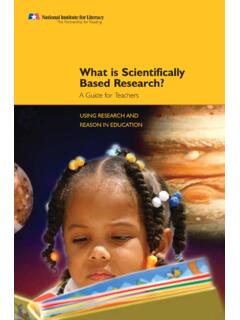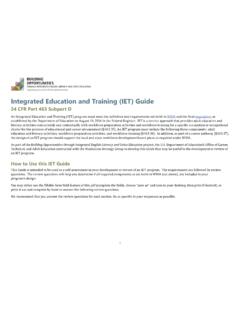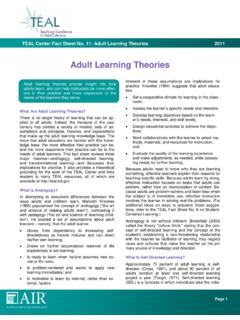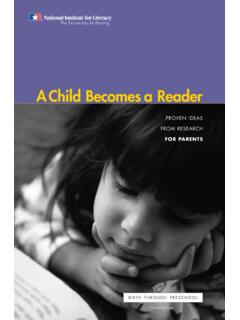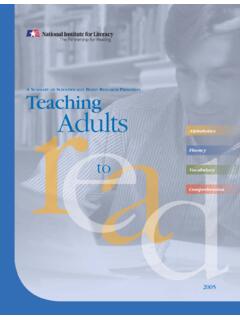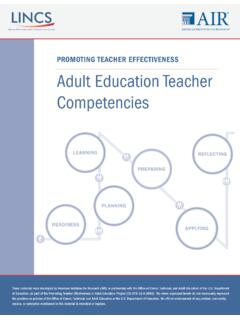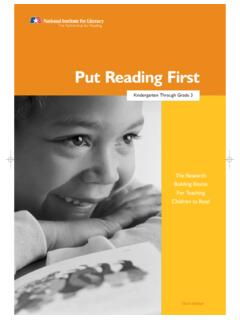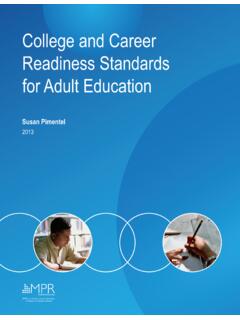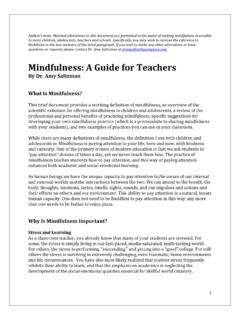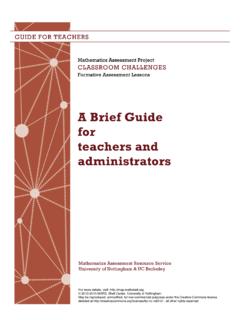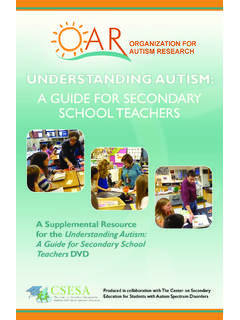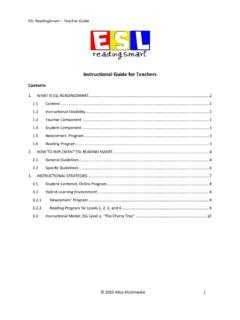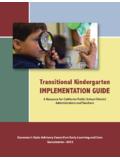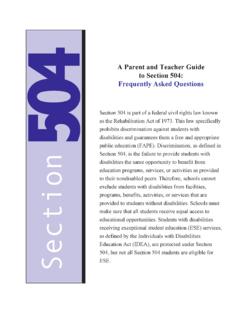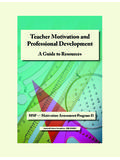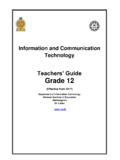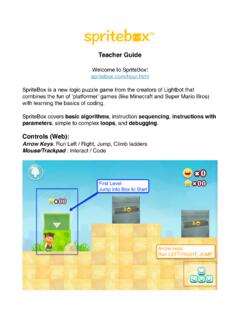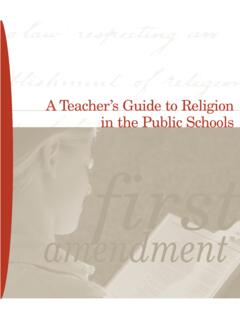Transcription of Teachers’ and Administrators’ Guide - LINCS
1 Charles A. MacArthur, University of DelawareJudith A. Alamprese, Abt Associates Knight, Atlanta Speech School2010 The National Institute for LiteracyWashington, DCMaking Sense of Decoding and Spelling: An Adult Reading Course of StudyTeachers and Administrators GuideThe Teachers and Administrators Guide , Lesson Plans, and Learner Activity Book that comprise the Making Sense of Decoding and Spelling: An Adult Reading Course of Study were prepared for dissemination under National Institute for Literacy Contract No. ED-NIL-09-C-0058 with the University of Delaware. The development and evaluation of this course of study was supported by a grant to the University of Delaware and Abt Associates Inc. jointly funded by the Eunice Kennedy Shriver National Institute of Child Health and Human Development (NICHD) (5R01HD43798), the National Institute for Literacy (NIFL), and the Office of Vocational and Adult Education (OVAE) of the Department of reading course of study materials were written by Charles A.
2 MacArthur, University of Delaware; Judith A. Alamprese, Abt Associates Inc.; and Deborah Knight, Atlanta Speech School. Lynn Reddy served as the contracting officer s representative. Patricia Bennett served as the Program Officer. The views expressed herein do not necessarily represent the positions or policies of the National Institute for Literacy. No official endorsement by the National Institute for Literacy of any product, commodity, or enterprise in this publication is intended or should be National Institute for Literacy, a Federal government agency, is a catalyst for advancing a comprehensive literacy agenda. The Institute bridges policy, research and practice to prompt action and deepen public understanding of literacy as a national Miller, Acting DirectorLynn Reddy, Deputy DirectorAugust 2010 The citation for this document should be: MacArthur, , Alamprese, , & Knight, D. (2010), Making Sense of Decoding and Spelling: An Adult Reading Course of Study, Teachers and Administrators Guide .
3 Washington, DC: The National Institute for document may be downloaded at Sense of Decoding and Spelling: An Adult Reading Course of Study iAcknowledgmentsMany individuals contributed to the development and evaluation of this course of study. We would like to thank our project officers, Peggy McCardle and Brett Miller from NICHD; Ricardo Hernandez from OVAE; and Sandra Baxter, Lynn Reddy and Patricia Bennett from NIFL for their support throughout the project. They were active participants in coordinating our efforts with our group of research projects. The funding from NIFL to disseminate the results of our work is much would also like to thank the many project staff who made the project possible through their hard work and dedication: Abt Associates Inc. Cristofer Price and Amanda Parsad for the statistical analyses, Fumiyo Tao for site recruit-ment, management and data collection, Kathie Mackin and Nancy Brigham for data collection, Daphne Garcia and Meredith Beck for data cod-ing and processing, and University of Delaware research assistants Allison Golinkoff, Leah Lembo, Katya Midgette, Zoi Philippakos, and Ximena Uribe.
4 Finally, we would like to thank the many adult education instructors and learners who contributed their time and knowledge in providing feedback on the Making Sense instruction. This feedback was essential to the improvement and success of the course of study. There are too many to name, but we deeply appreciate their contributions, without which this work would not have been A. MacArthur is a professor in the School of Education at the University of Delaware. His major research interests include adult literacy, writing development and instruction for struggling writers, and strategy instruction. He served as prin-cipal investigator on the project that developed and evaluated the Making Sense course of A. Alamprese is a principal associate at Abt Associates Inc. Her research and evaluation interests include adult reading instruction, adult education program quality, interagency coordina-tion, adult basic education and career pathways, and state systemic change.
5 She served as director of the experimental study in which the Making Sense course of study was evaluated. Deborah Knight is co-director of the Rollins Center for Language & Learning at the Atlanta Speech School, where she leads a team of coaches who provide comprehensive professional develop-ment in literacy for schools. She was an investigator on the project that developed the Making Sense course of Sense of Decoding and Spelling: An Adult Reading Course of Study is an evidence-based course of study designed to teach adult learners to decode and spell words more accurately and fluently. It is designed to be used as one compo-nent of a comprehensive adult reading course. The target population for the course is adult basic education (ABE) learners at the low-intermediate level (fourth to seventh grade equivalence level). It contains 30 scripted lesson plans. The course of study begins with a review of basic alphabetic decoding skills and then teaches the most com-mon and useful patterns of English words, and their applications in decoding, spelling, and fluent reading.
6 The course was evaluated in an experi-mental for the course of study include three documents including a set of charts: Teachers and Administrators Guide (this document) Lesson Plans Learner Activity BookThis Teachers and Administrators Guide is designed to assist ABE instructors in using the Making Sense course of study, and provides information for ABE administrators to use in sup-porting instruction with Making Sense. The Lesson Plans document includes the 30 scripted lessons with related charts and overhead transparencies. The Learner Activity Book is designed for use by individual learners in conjunction with the lessons; each learner should have a copy. It is important to have all materials to use the course effectively. All materials are designed to be downloaded from the Internet, printed and copied for use. ii Teachers and Administrators GuideTable of ContentsAcknowledgments..iAuthors.
7 IPreface .. iIntroduction ..1 Core Ideas and Features of the Course of Study..1 Summary of Research and Development ..3 Information for ABE Program Administrators on Program Supports for Implementing Making Sense..4 Foundational Knowledge Needed by Instructors ..6 Overview of Scope and Sequence of the Course of Study ..7 Lesson Format and Instructional Activities ..8 Guidelines for Teaching Making Sense .. 10 Integrating Making Sense With a Comprehensive Reading Course: Suggestions and Guidelines ..12 Some Recommendations for Assessment .. 14 Special Considerations for Non-native English Speakers .. 15 Scope and Sequence of Making Sense ..16 Some Resources and References..17 Some Assessment References .. 18 Other References .. 18 Making Sense of Decoding and Spelling: An Adult Reading Course of Study 1 IntroductionMaking Sense of Decoding and Spelling: An Adult Reading Course of Study Teachers and Administrators Guide provides information for adult basic education (ABE) instructors in teaching the Making Sense course.
8 Making Sense is an evidence-based course of study designed to teach adult learners to decode and spell words more accurately and fluently. As the title indi-cates, it focuses on decoding and spelling and includes instruction on developing fluent word recognition. However, it is not a comprehensive reading program. It is designed to be combined and integrated with instruction on vocabulary and comprehension. The course of study is designed to be used with ABE learners at the low-intermediate level (approximately fourth to seventh grade reading comprehension level) who have basic sight word knowledge, the ability to make sense of relatively simple texts, and knowledge of the alphabet and letter sounds. It is not assumed that learners must have decoding or word-attack skills, as many adults at this level have minimal skill at figuring out unfamiliar words. The course of study begins with a review of basic alphabetic decoding skills and then continues with the most common and useful spelling patterns of English.
9 Decoding skills are applied to multisyllabic words from the beginning of the course of Sense consists of 30 lessons that provide direct instruction in spelling patterns and their applications in decoding and fluent reading. The course of study was designed to be efficient and sensitive to the skills and motivations of adult learners. The goal of efficiency was important because learners attendance in adult education is generally limited in duration. While some learn-ers might need intensive training, many others might benefit from a more efficient approach. Thus, the course of study was designed with a limited number of lessons that move at a relatively rapid pace. The lessons are scripted to support teacher Teachers and Administrators Guide presents information about the core concepts, design, research base, and implementation of the Making Sense course of study. It contains guid-ance for ABE instructors about the knowledge that is needed to teach Making Sense, the struc-ture and content of the lessons in the course, and the integration of Making Sense within a compre-hensive adult reading course.
10 Also discussed in the Guide are ABE program policies and activities that can support a successful implementation of the Making Sense course, and the role of learner assessment in effective instruction. While Making Sense was developed for use in ABE reading classes, the population of adults who participate in ABE reading include both native and non-native English speakers. A section of this Guide discusses considerations in using the course with non-native speakers. Core Ideas and Features of the Course of StudyUnderstanding English Orthography (Why Words Are Spelled the Way They Are) In some alphabetic languages, like Finnish or Italian or Spanish, words are pretty much spelled the way they sound. Each letter has an associated phoneme, or speech sound. But in English, spell-ing and pronunciation are influenced not only by letter-sounds but also by patterns of letters ( , the e in cane is silent but changes the sound of the a ).
